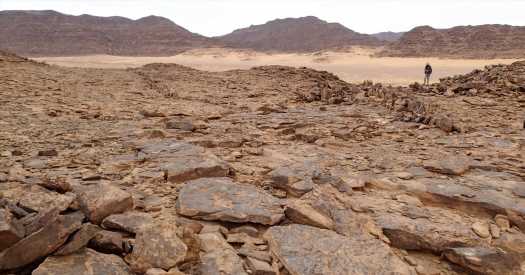Massive prehistoric stone structures found in desert landscapes from Saudi Arabia to Kazakhstan have baffled archaeologists for decades. Each can stretch for up to a few miles, and resembles a kite with tail strings in overall shape.
Recent studies have built a consensus that the so-called desert kites were used to trap and kill wild animal herds. But how ancient hunters conceived — and perceived — these grandiose structures has remained a mystery. The kites, in their entirety, are “only visible from the air,” said Rémy Crassard, an archaeologist at the French National Center for Scientific Research. “Even with our modern ways of envisaging our landscape, it’s still difficult for us archaeologists, scientists, scholars to make a proper map.”
Dr. Crassard and his colleagues were overjoyed in 2015 when they found two stone monoliths with precise depictions of nearby desert kites in Jordan and Saudi Arabia. Engraved between 7,000 and 9,000 years ago, these representations are by far the oldest known to-scale architectural plans recorded in human history, the team reported on Wednesday in the journal PLOS ONE. They also highlight how carefully planned the desert kites may have been by the ancient peoples who relied on them.
“It’s mind-blowing,” Dr. Crassard said, “to know and to show that they were able to have this mental conceptualization of very large spaces and to put that on a smaller surface.”
Over the last decade, as part of a project called Globalkites, Dr. Crassard and his colleagues have used satellite imagery to identify more than 6,000 desert kites of various shapes and sizes across the Middle East and West and Central Asia. Other researchers have uncovered stone engravings depicting these man-made enigmas while doing surveys and excavations. But, speaking of the engravings found previously, Dr. Crassard said “you couldn’t relate these drawings to a specific kite.” When they found the two kite depictions in Southeastern Jordan and Northern Saudi Arabia during field surveys, the archaeologists knew that they were special. At first, they noted the presence of three defining kite features. There were “tail strings,” which represent more or less contiguous lines of stones. These converge into a walled enclosure resembling the kite’s “body.” And along the body’s edges, pits had been dug. Archaeologists suspect that groups of animals such as gazelles followed these stone lines or were chased along them before being funneled into the enclosure, where hunters killed the animals, and used the strategically placed pits to trap those attempting to escape. Very quickly, the team recognized that these engravings matched the shape and structure of kites seen nearby. In Southeastern Jordan, for example, the tail lines of kites curve as they converge into enclosures — a peculiarity also visible on the engraved stone. “When we look at the satellite and aerial images that we take in the field, it’s like a drawing of the actual kites in this area,” said Mohammad Tarawneh, an archaeologist at Al-Hussein Bin Talal University in Jordan and an author of the study. Mathematical models, too, indicated that the kites in the Jordan-Saudi region where the team worked were the closest match when researchers compared the geometry of the two engravings with a total of 69 kites from a variety of regions. Shape comparisons with such nearby kites also revealed that the depictions were to scale. The researchers inferred the ages of the engravings by using geological dating tools to determine how long ago the corresponding local kite structures were built. What remains unknown is whether these depictions were prepared as blueprints to aid in the construction of the kites, or served as maps for hunters. The engravings could also be symbolic commemorations of the desert kites, which may have been an important part of the cultural identity of the ancient peoples who made and used them, said Wael Abu-Azizeh, an archaeologist with The French Institute of the Near East in Jordan and an author of the study. Yorke Rowan, an archaeologist at the University of Chicago who was not involved in the study, said the engravings cited in the paper are a great find. He called it remarkable that people on the ground were precisely depicting things that can only be seen fully from above today. Finding this mental mastery of space opens a new window into the minds of these ancient hunters. Source: Read Full Article



